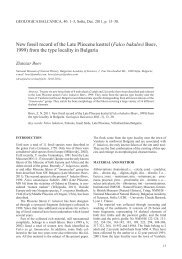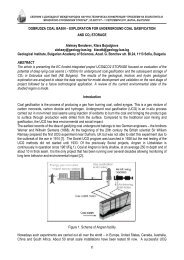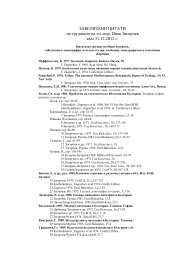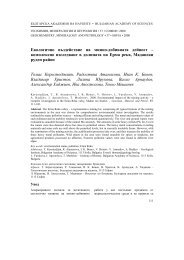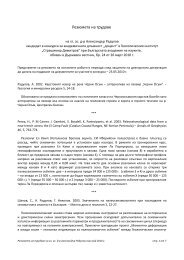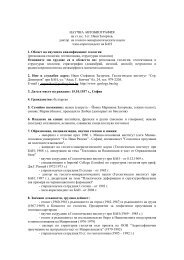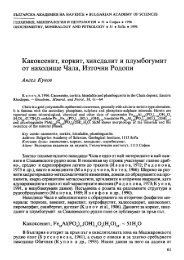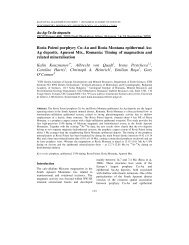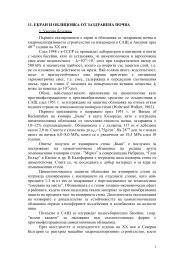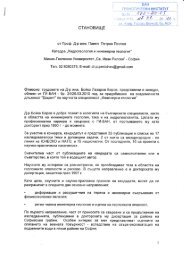Background contents of some minor and trace elements in the rocks ...
Background contents of some minor and trace elements in the rocks ...
Background contents of some minor and trace elements in the rocks ...
You also want an ePaper? Increase the reach of your titles
YUMPU automatically turns print PDFs into web optimized ePapers that Google loves.
acid <strong>and</strong> moderate acid <strong>rocks</strong>. Most <strong>in</strong>tensively differentiated by rock types are <strong>the</strong> <strong>contents</strong> <strong>of</strong>Ti, Cr, Ni, Hg. The mean <strong>contents</strong> derived for all <strong>rocks</strong> on Bulgarian territory are <strong>the</strong> follow<strong>in</strong>g(<strong>in</strong> ppm): Be – 2, Sr – 280, Ba – 506, Sc – 9, Ti – 2956, V – 73, Cr – 25, Mo – 1, W – 0.7, Mn– 650, Co – 10, Ni – 17, Cu – 20, Zn – 45, Cd – 2.3(?), Hg – 0.03, Sn – 3, Pb – 21 <strong>and</strong> As –2.2. The background <strong>contents</strong> obta<strong>in</strong>ed for <strong>the</strong> <strong>elements</strong> studied (C BG) show good co<strong>in</strong>cidencewith <strong>the</strong> respective recent averages for <strong>the</strong> upper cont<strong>in</strong>ental crust (C UC) calculated by Wedepohl(1995). The coefficients <strong>of</strong> concentration (C BG/C UC) are: Cu 1.40 – V 1.38 – Sc 1.29 – Pb 1.24 –Mn 1.23 – Sn 1.20 – As 1.10 – Ti 0.95 – Ni 0.91 – Sr 0.89 – Zn 0.87 – Co 0.86 – Ba 0.76 –Mo 0.71 – Cr 0.71 – Be 0.65 – Hg 0.54 – W 0.50. The reference values obta<strong>in</strong>ed for <strong>the</strong>background <strong>contents</strong> <strong>of</strong> Be, Sr, Ba, Sc, Ti, V, Cr, Mo, W, Mn, Co, Ni, Cu, Zn, Hg, Sn, Pb <strong>and</strong> As(Cd excluded) could be accepted as sufficiently reliable st<strong>and</strong>ards for comparative geochemical,petrological, metallogenic <strong>and</strong> ecologic <strong>in</strong>vestigations <strong>and</strong> as regional Clarkes <strong>of</strong> <strong>the</strong>se <strong>elements</strong>for <strong>the</strong> Bulgarian territory <strong>and</strong> <strong>the</strong> Balkan region.Christova, J., Christov, D., Kuik<strong>in</strong>, S. 2007. <strong>Background</strong> <strong>contents</strong> <strong>of</strong> <strong>some</strong> <strong>m<strong>in</strong>or</strong> <strong>and</strong> <strong>trace</strong><strong>elements</strong> <strong>in</strong> <strong>the</strong> <strong>rocks</strong> on Bulgarian territory. – Geologica Balc., 36, 1—2; 65—76.Key words: <strong>m<strong>in</strong>or</strong> <strong>and</strong> <strong>trace</strong> <strong>elements</strong> <strong>in</strong> <strong>rocks</strong>, background <strong>contents</strong>, regional Clarkes.IntroductionUnderst<strong>and</strong><strong>in</strong>g <strong>of</strong> <strong>the</strong> background element <strong>contents</strong>is based on Vernadskiy’s law: <strong>the</strong> chemical <strong>elements</strong>are spread <strong>and</strong> dispersed comparatively uniformly<strong>and</strong> ubiquitously <strong>in</strong> <strong>the</strong> Earth crust; <strong>the</strong> dispersedspread<strong>in</strong>g is a normal <strong>and</strong> common state <strong>of</strong> existence<strong>of</strong> <strong>the</strong> <strong>elements</strong> (Âåðíàäñêèé, 1954). All types<strong>of</strong> natural formations (<strong>rocks</strong>, soils, water, air, plants,etc.) are characterized by <strong>the</strong>ir own comparativelystable element content’s levels which are consideredas background ones.The background <strong>contents</strong> <strong>of</strong> <strong>the</strong> chemical <strong>elements</strong><strong>in</strong> <strong>the</strong> <strong>rocks</strong> may be assessed as <strong>the</strong> follow<strong>in</strong>g referencevalues: (a) global values, also known as “Clarkes”(Darnley, 1995; Îâ÷èííèêîâ, 1990) – determ<strong>in</strong>edfor <strong>the</strong> Earth crust <strong>and</strong>/or its layers; (b) regionalvalues (regional Clarkes) – obta<strong>in</strong>ed for considerablylarge territories; (c) local geochemical background– characteristic for limited, restricted areas,l<strong>and</strong>scapes, etc. Reference values for backgroundconcentrations <strong>of</strong> <strong>the</strong> <strong>elements</strong> can be obta<strong>in</strong>ed bygeneraliz<strong>in</strong>g <strong>in</strong> a given hierarchical level, elaborat<strong>in</strong>g<strong>and</strong> <strong>in</strong>terpret<strong>in</strong>g <strong>the</strong> available analytical data on<strong>the</strong> element <strong>contents</strong>.On <strong>the</strong> <strong>the</strong>oretical basis cited above one <strong>of</strong> <strong>the</strong>most significant results <strong>of</strong> <strong>the</strong> geochemical <strong>in</strong>vestigationscarried out dur<strong>in</strong>g <strong>the</strong> 20-th century is <strong>the</strong>derivation <strong>of</strong> geochemical st<strong>and</strong>ards – referencevalues for <strong>the</strong> mean element <strong>contents</strong> (Clarkes) <strong>in</strong><strong>the</strong> ma<strong>in</strong> types <strong>of</strong> <strong>rocks</strong> <strong>and</strong> <strong>in</strong> general for <strong>the</strong> Earthcrust, only for <strong>the</strong> cont<strong>in</strong>ental crust, for its upper<strong>and</strong> lower layers, etc. – Turekian & Wedepohl (1961),Âèíîãðàäîâ (1962), Îâ÷èííèêîâ (1990), ßðîøåâñêèé(1990), Wedepohl (1995), Rudnick & Gao(2003) <strong>and</strong> o<strong>the</strong>rs. These studies concern ma<strong>in</strong>ly <strong>the</strong>upper cont<strong>in</strong>ental crust which represents 31.7% <strong>of</strong><strong>the</strong> Earth crust exposed on <strong>the</strong> surface <strong>and</strong> accessiblefor <strong>in</strong>vestigations. At <strong>the</strong> same time similar assessmentshave been obta<strong>in</strong>ed also for <strong>some</strong> <strong>in</strong>dividualregions <strong>and</strong> countries, for example, for Australia,Canada, F<strong>in</strong>l<strong>and</strong>, Germany, Great Brita<strong>in</strong>, India,Portugal, Russia, USA, etc. (cited <strong>in</strong> Wedepohl,1995 <strong>and</strong> Rudnick & Gao, 2003), for Ch<strong>in</strong>a (Gao etal., 1998; Tong, 1995), Central Kazakhstan (Ãëóõàí,Ñåðûõ, 2000) <strong>and</strong> o<strong>the</strong>rs.The geochemical problem for <strong>the</strong> element backgroundconcentrations <strong>in</strong> <strong>the</strong> <strong>rocks</strong> was elaborated<strong>in</strong> Bulgaria <strong>in</strong> <strong>the</strong> 60-ies <strong>of</strong> <strong>the</strong> past century when<strong>the</strong> first quantitative assessments <strong>of</strong> concentrations<strong>of</strong> <strong>some</strong> <strong>m<strong>in</strong>or</strong> <strong>and</strong> <strong>trace</strong> <strong>elements</strong> <strong>in</strong> <strong>rocks</strong> have beenpublished by E. Alexiev. Dur<strong>in</strong>g <strong>the</strong> last 40 years, <strong>in</strong>connection with different geochemical, petrological,lithological, metallogenic <strong>and</strong> environmental <strong>in</strong>vestigations,a significant <strong>in</strong>formation on <strong>the</strong> concentrations<strong>of</strong> a great number <strong>of</strong> chemical <strong>elements</strong> <strong>in</strong><strong>in</strong>dividual k<strong>in</strong>ds <strong>of</strong> <strong>rocks</strong> <strong>in</strong> different regions <strong>of</strong> <strong>the</strong>country has been piled up. With a broader scope are<strong>the</strong> <strong>in</strong>vestigations on <strong>the</strong> geochemistry <strong>of</strong> <strong>the</strong> granitoids<strong>in</strong> Bulgaria (Alexiev et al., 1980 – unpublished),on <strong>the</strong> crystall<strong>in</strong>e basement <strong>of</strong> South Bulgaria (Arnaudovet al., 1995 – unpublished) <strong>and</strong> on <strong>the</strong> sedimentary<strong>rocks</strong> <strong>of</strong> Paleozoic age by S.Yanev. In spite<strong>of</strong> this, published data for <strong>the</strong> mean <strong>contents</strong> <strong>of</strong> <strong>the</strong>most <strong>of</strong> chemical <strong>elements</strong> <strong>in</strong> <strong>the</strong> <strong>rocks</strong> <strong>in</strong> Bulgariaare relatively rare.Systematic <strong>in</strong>vestigations <strong>of</strong> <strong>the</strong> data for <strong>the</strong><strong>contents</strong> <strong>of</strong> <strong>m<strong>in</strong>or</strong> <strong>and</strong> <strong>trace</strong> <strong>elements</strong> <strong>in</strong> <strong>the</strong> <strong>rocks</strong> on<strong>the</strong> Bulgarian territory are carried out <strong>and</strong> publishedfrom <strong>the</strong> authors <strong>in</strong> <strong>the</strong> period 2000—2005: for heavymetals <strong>and</strong> arsenic – Cr, Mn, Co, Ni, Cu, Zn, As,Cd, Hg <strong>and</strong> Pb (Kuik<strong>in</strong> et al., 2001) <strong>and</strong> for litophyle<strong>elements</strong> – Be, Sr, Ba, Sc, Ti, V, Mo, W <strong>and</strong> Sn(Christova & Christov, 2005).The present geochemical study is po<strong>in</strong>ted on <strong>the</strong><strong>contents</strong> <strong>in</strong> <strong>the</strong> <strong>rocks</strong> <strong>in</strong> Bulgaria <strong>of</strong> n<strong>in</strong>eteen <strong>elements</strong>known as <strong>m<strong>in</strong>or</strong> <strong>and</strong> <strong>trace</strong> components <strong>in</strong> <strong>the</strong>chemical composition <strong>of</strong> <strong>the</strong> <strong>rocks</strong> – Be, Sr, Ba, Sc,Ti, V, Cr, Mo, W, Mn, Co, Ni, Cu, Zn, Cd, Hg, Sn, Pb<strong>and</strong> As. The aims <strong>of</strong> <strong>the</strong> <strong>in</strong>vestigation are: 1) togeneralize <strong>the</strong> earlier studies <strong>of</strong> <strong>the</strong> authors on <strong>the</strong>same problem; 2) to improve <strong>and</strong> confirm on abroader basis <strong>the</strong> results obta<strong>in</strong>ed for background<strong>contents</strong> <strong>of</strong> <strong>the</strong>se <strong>elements</strong> <strong>in</strong> <strong>the</strong> ma<strong>in</strong> types <strong>of</strong> <strong>rocks</strong>66



